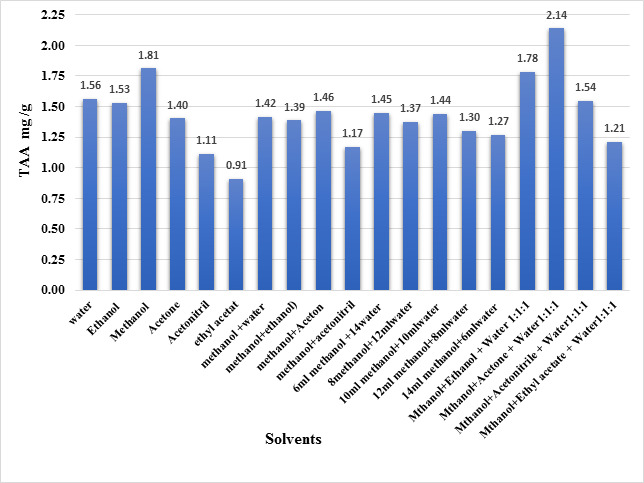Development and Optimization of the Sample Preparation Method to Determine the Antioxidants in the Yemeni Almond
Keywords:
Yemeni Almond, Antioxidants, Polyphenols, Flavonoids, Method OptimizationAbstract
Almonds are rich in phenolic compounds with health benefits, but their matrix complexity makes measuring an- tioxidants challenging, requiring a sufficient extraction technique and high method sensitivity. This study aimed to develop, optimize, and validate an extraction method to assay the total antioxidant activity (TAA), total polyphenol content (TPC), and total flavonoid content (TFC) of different parts of almonds, including whole, kernel, and skin almond samples. Conventional extraction methods were compared with ultrasound assisted extraction efficiency. This study was performed on 34 cultivated Yemeni samples and 12 samples of imported almonds. The results showed that the combined vortex/sonication extraction method with methanol: acetone: water at a ratio of 1:1:1v/v/v was the most efficient, yielding the highest quantity of TAA, TPC, and TFC contents from the almond samples. The extraction method had high linearity and good sensitivity with a limit of detection (LOD) values of 0.019, 0.024, and 0.099 ppm for ascorbic acid, gallic acid, and quercetin respectively. The Yemeni almond had a higher antioxidant content than the imported types, with TAA, TPC, and TFC values ranging from 2.54±0.01–8.20±0.01 mg AAE/g (Ascorbic Acid Equivalent per g of almond sample), 0.75±0.01-1.91±0.03 mg GAE/g (Gallic Acid Equivalent per g of almond sample), 0.03±0.002-0.24±0.020 mg QE/g (Quercetin Equivalent per g of almond sample) respectively.
Downloads

Published
How to Cite
Issue
Section
Copyright (c) 2024 fatima murshed, Anass A. Alnedhary, Mahfoudh M. AL-Hamadi, Dalia Al-kufl

This work is licensed under a Creative Commons Attribution-NonCommercial-NoDerivatives 4.0 International License.
